Archived Fire Damage Blog Posts
Tips for handling with fire
7/22/2022 (Permalink)
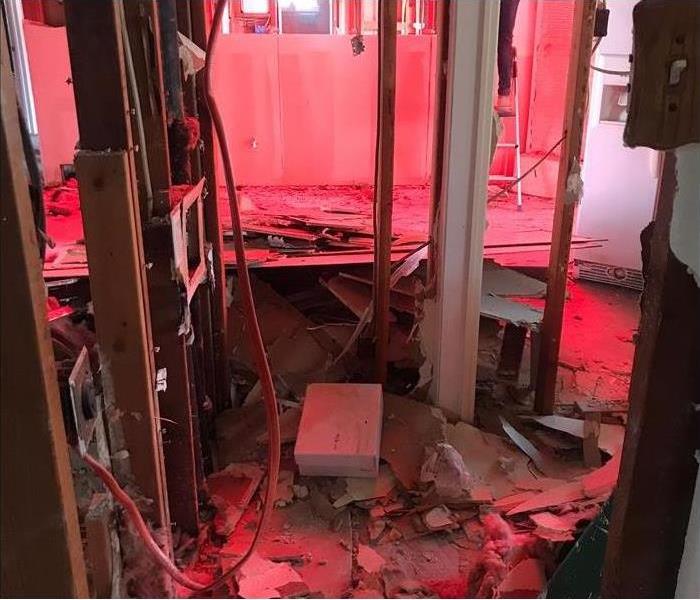 Fire tips
Fire tips
After a fire emergency, you do not know how to act. It is essential to keep in mind that specific residues of what may remain are dangerous to health, but no worries, We got you! Below, we will provide you with tips that will help you manage the situation; take a look at them:
-Have a professional examine your home to make sure it’s ready and safe.
-Send text messages or use social media to reach out to your family and friends.
-Proceed with caution: maintain a “fire watch” and check your home and surrounding areas for tiny, lingering embers.
-Do not drink, prepare food or wash with water until officials deem the water source safe.
-Photograph any damages for your records and contact your insurance agency.
-Outline clear pathways to exit doors.
-Conduct regular fire drills.
-Use flame-retardant materials in interiors.
Call SERVPRO – you need professional services; get the experts before moving to the next step. You must consider the above for better management; we will always be there to take care of your
Cleaning and removing smoke odor
7/22/2022 (Permalink)
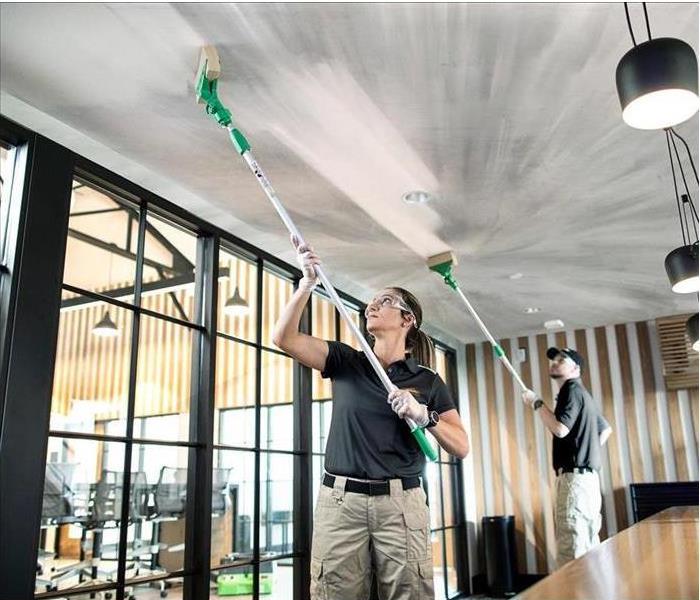 Like it never even happened.
Like it never even happened.
Products containing tri-sodium phosphate (TSP) can reduce odors in fabrics, but we need to read the label for directions and safety instructions.
- Test clothing before using any treatment, and follow the manufacturer's instructions. Smoke odor and soot can be removed from clothing that can get bleached. Measure 4 to 6 tbsp of Tri-Sodium Phosphate and 1 cup of household cleaner or chlorine bleach for every gallon of warm water you will use. Alternatively, consider washing clothes in cold water with your usual household laundry detergent and adding one pure vanilla extract tablespoon.
- To remove soot and smoke from walls, furniture and floors, use a mild soap or detergent or mix 4 to 6 tbsp of tri-sodium phosphate and 1 cup of household cleaner or chlorine bleach to every gallon of warm water. Wear rubber gloves and rinse surfaces with clear warm water and dry thoroughly.
- Wash walls one small area at a time, working from the floor up to prevent streaking, and rinse with clear water immediately; ceilings should be cleaned up last. Do not repaint until walls and ceilings are completely dry. Washable wallpaper can be cleansed like painted walls but refrain from wetting through the paper. You can use a commercial paste to repaste any loose edges or sections.
Other Cleaning Tips
Consult a SERVPRO professional about replacing drywall and insulation that has been soaked by water from fire hoses. As a result, it can not be dried out and maintain structural integrity or resistance to mold and mildew.
Fire extinguishers
7/19/2022 (Permalink)
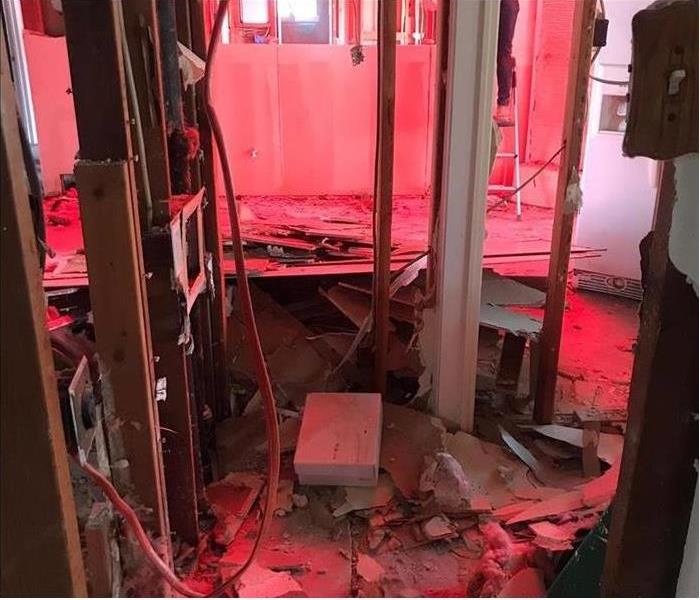 Damage caused by fire
Damage caused by fire
Keep fire safety in mind by following a few simple safety tips. Enjoy time with your loved ones, and keep yourself and your family safe from fire.
Here is a significant fact that we should consider in our spaces.
How many fire extinguishers should I have?
Every home needs at least one fire extinguisher, and most should have at least two or three. The number of fire extinguishers you should have in your home depends on the size of your house, if you have a garage or workshop, and if your household is multi-level or not.
The minimum recommendation is to have a single extinguisher rated 2-A:10-B: C or higher in your kitchen, garage, or workshops, near doors used as an escape route, and on every level of your home.
Flames need fuel, oxygen, and heat to burn. Fire extinguishers are designed to remove one of these elements by applying an agent that either cools the burning fuel or releases or displaces the surrounding oxygen. Fire extinguishers contain either water or a smothering material, such as CO2; by pulling out the safety pin and depressing the lever at the top of the cylinder, the fire extinguishing material is released under high pressure.
Don't hesitate to call us; we would love to take care of you! SERVPRO of Southwest Irving is always at your service.
Cooking
7/19/2022 (Permalink)
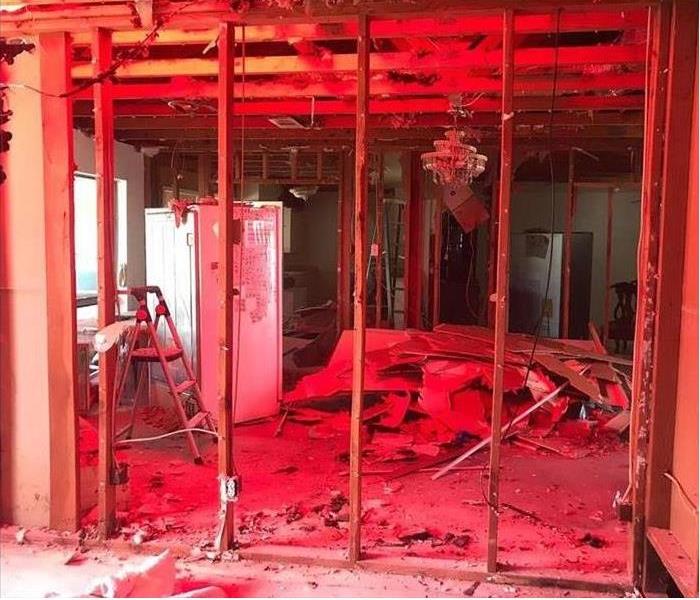 Caution while cooking
Caution while cooking
Did you know that commonly fires start in the kitchen?
Cooking is the leading cause of home fires and related injuries due to burning.
Remember to keep children away from hot foods, liquids, matches, utility lighters, and Sharp utensils. Cover your pot or pan with a lid and turn off the burner if you have a cooking tire. Think cooking safety - use safety tools such as kitchen gloves and an apron to protect skin and clothing.
Cook with care.
Remaining in the kitchen while food is cooking, don't leave cooking food unattended. Have a fire extinguisher readily available for use. Remember, Pull Aim Squeeze Sweep. Ensure you test your smoke detectors before cooking; never throw water on a cooking fire; this will only spread the flames.
Please take the following into account to prevent a fire from starting, do not hesitate to contact us at SERVPRO of Garden Grove West
In the Event of A Natural Disaster, Please Consider
3/23/2022 (Permalink)
In the event of a natural disaster, there are many factors to consider. In the moment, a person may feel the stress, shock, and various other emotions after suffering a devastating loss to their home, such a fire loss or another natural disaster that has significantly altered their home and ability to safely dwell in it.
First and foremost, ensuring your family’s safety is top priority.
Afterward, there are a few practical steps to help you get back on track and living life as best as possible.
Here are a few topics to consider:
- Insurance Claim- Contact your insurance agent or insurance company as soon as possible to report the disaster and damage to your home. They will guide you in the next steps with your claim.
- Bills and Creditors- Contact your local utility companies, internet provider, etc, if your home is temporarily or permanently uninhabitable, so they may turn off service immediately and you can stop paying unnecessary services for the moment. Contact any creditors you may have and ask for an extension to pay, due to the circumstances. Most creditors are willing to work with their consumers, and especially if they are notified before the payment’s due date.
- Replacing Vital Documents After a Fire/ Natural Disaster Loss – There are many documents that may need to be replaced if they have been lost or damaged due to a fire or other natural disaster. The Red Cross has provided a very resourceful article on where to replace vital documents in the event of a natural disaster here, which includes, government issued IDs’, passports, birth, death & marriage certificates and much more. To access this list: https://www.redcross.org/get-help/disaster-relief-and-recovery-services/recovering-financially.html
- Recovering Emotionally – Recovering emotionally from a severe loss is critical in a person’s overall health and wellbeing. There are many different ways to cope and seek healing, and this can be different from individual to individual. A resource available, among many others is located here: https://www.redcross.org/get-help/disaster-relief-and-recovery-services/recovering-emotionally.html
Please keep in mind, recovering from a significant loss takes time. Please seek help in any and all necessary measures to safeguard your mental, emotional and physical health. The American Red Cross, (Redcross.org,) is a distinguished resource with many related subjects pertaining to fire loss/ natural disaster loss & recovery. We hope this article is of help to you and your family should you experience a natural disaster.
Fire Damage Restoration
1/26/2022 (Permalink)
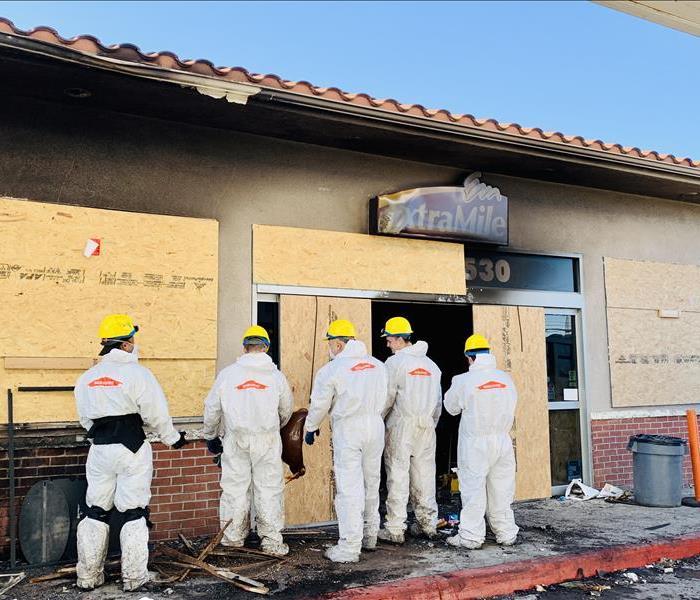 Our team of experts in action at a fire restoration project in Anaheim, Ca. Proudly serving the community & nationwide in disaster relief efforts.
Our team of experts in action at a fire restoration project in Anaheim, Ca. Proudly serving the community & nationwide in disaster relief efforts.
Fire Damage Restoration
Our top priority in fire damage restoration is to restore your home or business to its pre-fire condition, "Like it never even happened." As the prestigious leading fire damage restoration company, SERVPRO is the premier provider for fire damage and water damage restoration, including removing smoke odors and deep cleaning soot from carpets, walls, and upholstery, in residential, commercial and multi-family buildings.
Restoring Your Home after Experiencing Fire Damage
Our main goal is to restore your home and valuables to its pre-fire condition in an excellent manner. Here at SERVPRO, we are known nationwide for our high level of trained, experienced, properly equipped and knowledgeable staff. We effectively and properly restore homes to their pre-fire condition, using the best industry measures and expertise, assuring home owners that every aspect of our service is professionally and efficiently handled, leaving homeowners with peace of mind, they are being taken care of properly from beginning to end.
Getting Back to Business After a Fire
Any disruption in business can critically affect a business owner’s bottom line. Here at SERVPRO, we have an excellent and nationwide network of professionals ready to respond immediately to your emergency fire damage phone call. Our top priority is to efficiently and effectively help you get back to business as soon as possible after a fire emergency. Rest assured, you are in good hands every step of the way.
Why Ash is Messy When Cleaning
5/5/2020 (Permalink)
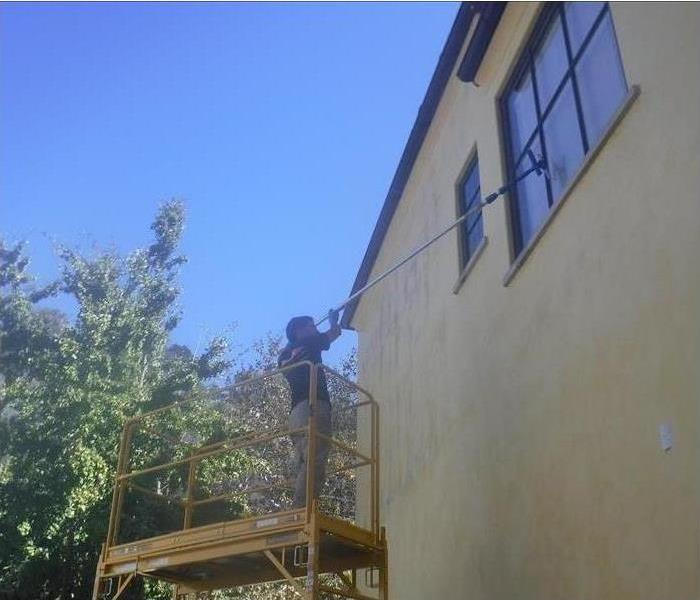 All of our technicians have received the best training and knowledge to get the job done.
All of our technicians have received the best training and knowledge to get the job done.
When a water or fire damage strikes, the aftermath can be stressful and a whole lot of messy. Did you know fire and water emergencies require major cleanup by specialists?
When a fire occurs, it is burning not only wood but everything else that makes up a structure. This includes insulation, paint, drywall, vinyl and plaster to name a few. Because these materials are not meant to be burned (the components can be harmful), the ash, soot and debris requires a specialist to handle it.
Ash for example is not easy to clean. Once wiped, it will smear and make the walls or furniture discolored. It can easily be sent up into the air when wiped just to settle back onto another section of your home or office. SERVPRO of Central Glendale‘s commercial grade cleaning products gets the ash cleaned fast and our technicians have gone through hours of training for the knowledge on how to do so.
If you are having trouble with the aftermath of a fire, please do not hesitate to give us a call at (714) 622-5096 to speak to a specialist today.
Smoke and soot clean up
4/28/2020 (Permalink)
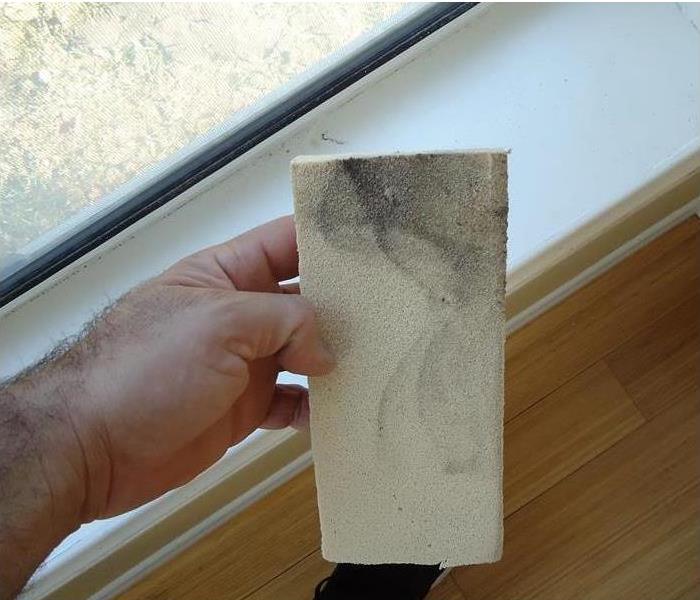 Smoke Damage Can Cause a Pervasive Odor in Your Home.
Smoke Damage Can Cause a Pervasive Odor in Your Home.
Smoke and soot is very invasive and can penetrate various cavities within your home, causing hidden damage and odor. Our smoke damage expertise and experience allows us to inspect and accurately assess the extent of the damage to develop a comprehensive plan of action.
Smoke and soot facts:
- Hot smoke migrates to cooler areas and upper levels of a structure.
- Smoke flows around plumbing systems, seeping through the holes used by pipes to go from floor to floor.
- The type of smoke may greatly affect the restoration process.
Different Types of Smoke
There are two different types of smoke–wet and dry. As a result, there are different types of soot residue after a fire. Before restoration begins, SERVPRO of Garden Grove will test the soot to determine which type of smoke damage occurred. The cleaning procedures will then be based on the information identified during pretesting. Here is some additional information:
Wet Smoke – Plastic and Rubber
- Low heat, smoldering, pungent odor, sticky, smeary. Smoke webs are more difficult to clean.
Dry Smoke – Paper and Wood
- Fast burning, high temperatures, heat rises therefore smoke rises.
Protein Fire Residue – Produced by evaporation of material rather than from a fire
- Virtually invisible, discolors paints and varnishes, extreme pungent odor.
Our Fire Damage Restoration Services
Since each smoke and fire damage situation is a little different, each one requires a unique solution tailored for the specific conditions. We have the equipment, expertise, and experience to restore your fire and smoke damage. We will also treat your family with empathy and respect and your property with care.
Have Questions about Fire, Smoke, or Soot Damage?
Call Us Today – (714) 660-0701
What to Do During a Fire
4/25/2019 (Permalink)
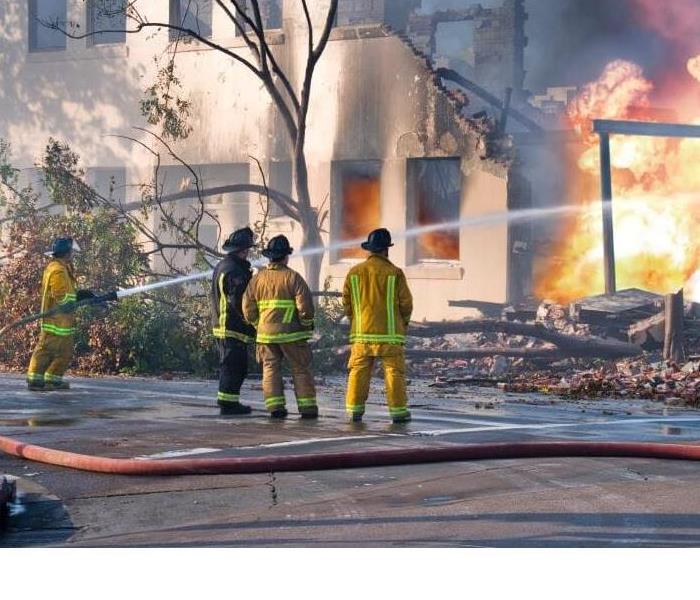 Know What to do During a Fire
Know What to do During a Fire
- Get out as quickly and as safely as possible. The less time you are exposed to poisonous gases, the safer you will be.
- If a stove fire starts, slide a lid over the burning pan and turn off the burner. Leave the lid in place until the pan is completely cool. Using a lid to contain and smother the fire is your safest action. Getting the fire extinguisher or baking soda to extinguish the fire delays action. Flour and other cooking products can react explosively to flame and should never be sprinkled over fire. Moving the pan can cause serious injury or spread the fire. Never pour water on grease fires.
- If you try to use a fire extinguisher on a fire and the fire does not immediately die down, drop the extinguisher and get out. Most portable extinguishers empty in 8 to 10 seconds. After some residential fires, people have been found dead with fire extinguishers near them or in their arms.
- If you are escaping through a closed door, feel the door, cracks, and doorknob with the back of your hand before opening the door. If it is cool and there is no smoke at the bottom or top, open the door slowly. If you see smoke or fire beyond the door, close it and use your second way out. If the door is warm, use your second way out. It is a natural tendency to automatically use the door, but fire may be right outside. Feeling the door will warn you of possible danger.
- If you see smoke or fire in your first escape route, use your second way out. The less time you are exposed to poisonous gases or flames, the safer you will be.
- If you must exit through smoke, crawl low under the smoke to your exit. Fires produce many poisonous gases. Some are heavy and will sink low to the floor; others will rise carrying soot towards the ceiling. Crawling with your head at a level of 1 to 2 feet above the ground will temporarily provide the best air.
- Close doors behind you as you escape to delay the spread of the fire.
- If smoke, heat, or flames block your exit routes and you cannot get outside safely, stay in the room with the door closed. Open the window for ventilation, and hang a sheet outside the window so firefighters can find you. Wait by the window for help. The first thing firefighters will do when they arrive at a fire is check for trapped persons. Hanging a sheet out lets them know where to find you. If there is a phone in the room, call the fire department and tell them where you are.
- Once you are out, stay out! Firefighters are trained and equipped to enter burning buildings. If someone is still inside, direct them to that person's probable location.
- Get out first, away from toxic smoke and gases, then call the fire department from a neighbor's home or from an outside phone. If a portable phone is handy during your escape, you may take it with you, but do not waste precious time looking for one. Use your neighbor's phone, a car phone, or nearby pay phone to call for help.






 24/7 Emergency Service
24/7 Emergency Service







